AAFA美国服装鞋类协会RSL_第8版-中文
- 格式:pdf
- 大小:337.81 KB
- 文档页数:43
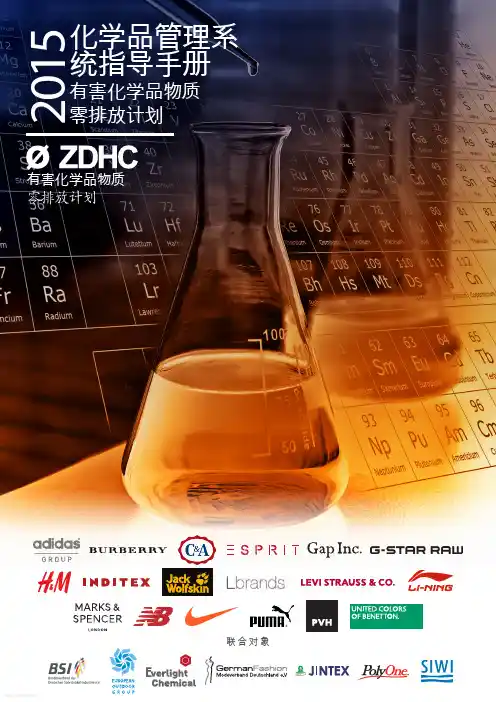
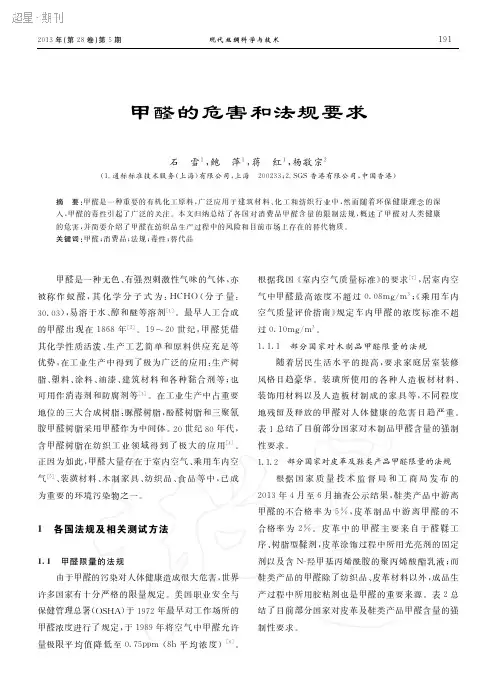
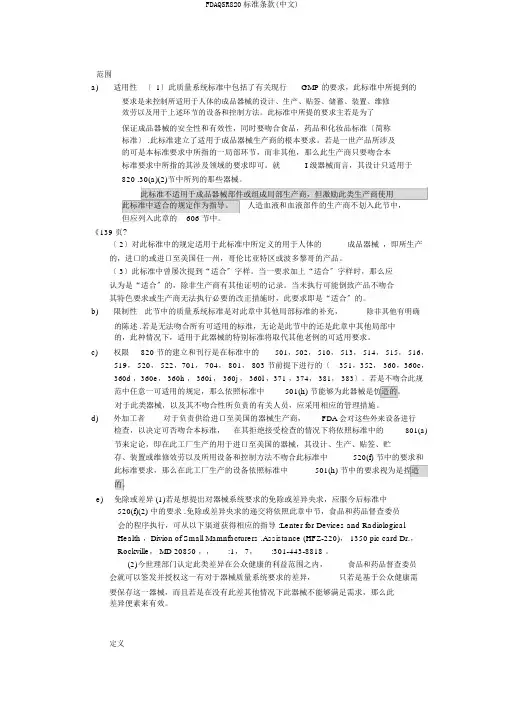
范围a)适用性〔1〕此质量系统标准中包括了有关现行GMP 的要求,此标准中所提到的要求是来控制所适用于人体的成品器械的设计、生产、贴签、储蓄、装置、维修效劳以及用于上述环节的设备和控制方法。
此标准中所提的要求主若是为了保证成品器械的安全性和有效性,同时要吻合食品,药品和化妆品标准〔简称标准〕 .此标准建立了适用于成品器械生产商的根本要求。
若是一世产品所涉及的可是本标准要求中所指的一局部环节,而非其他,那么此生产商只要吻合本标准要求中所指的其涉及领域的要求即可。
就I 级器械而言,其设计只适用于820.30(a)(2)节中所列的那些器械。
此标准不适用于成品器械部件或组成局部生产商,但激励此类生产商使用此标准中适合的规定作为指导。
人造血液和血液部件的生产商不划入此节中,但应列入此章的606 节中。
《139 页?〔 2〕对此标准中的规定适用于此标准中所定义的用于人体的成品器械,即所生产的,进口的或进口至美国任一州,哥伦比亚特区或波多黎哥的产品。
〔 3〕此标准中曾屡次提到“适合〞字样。
当一要求加上“适合〞字样时,那么应认为是“适合〞的,除非生产商有其他证明的记录。
当未执行可能倒致产品不吻合其特色要求或生产商无法执行必要的改正措施时,此要求即是“适合〞的。
b)限制性此节中的质量系统标准是对此章中其他局部标准的补充,除非其他有明确的陈述 .若是无法吻合所有可适用的标准,无论是此节中的还是此章中其他局部中的,此种情况下,适用于此器械的特别标准将取代其他老例的可适用要求。
c)权限820 节的建立和刊行是在标准中的501,502, 510, 513, 514, 515, 516,519, 520, 522,701, 704, 801, 803 节前提下进行的〔351,352, 360,360c,360d ,360e, 360h , 360i , 360j , 360l ,371 ,374, 381, 383〕。
若是不吻合此规范中任意一可适用的规定,那么依照标准中501(h) 节能够为此器械是仿造的。
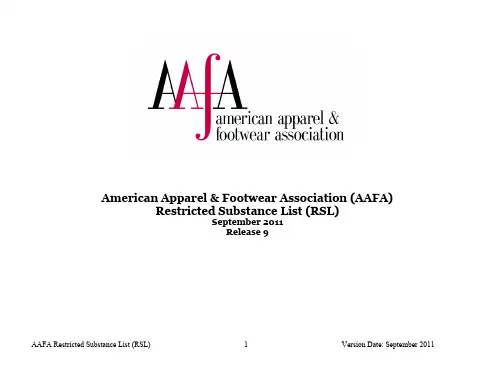
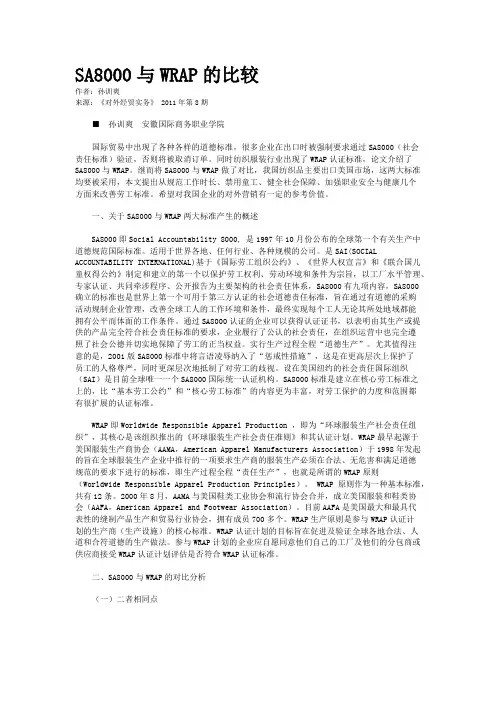
SA8000与WRAP的比较作者:孙训爽来源:《对外经贸实务》 2011年第8期■孙训爽安徽国际商务职业学院国际贸易中出现了各种各样的道德标准,很多企业在出口时被强制要求通过SA8000(社会责任标准)验证,否则将被取消订单。
同时纺织服装行业出现了WRAP认证标准,论文介绍了SA8000与WRAP。
继而将SA8000与WRAP做了对比,我国纺织品主要出口美国市场,这两大标准均要被采用,本文提出从规范工作时长、禁用童工、健全社会保障、加强职业安全与健康几个方面来改善劳工标准。
希望对我国企业的对外营销有一定的参考价值。
一、关于SA8000与WRAP两大标准产生的概述SA8000即Social Accountability 8000, 是1997年10月份公布的全球第一个有关生产中道德规范国际标准。
适用于世界各地、任何行业、各种规模的公司。
是SAI(SOCIAL ACCOUNTABILITY INTERNATIONAL)基于《国际劳工组织公约》、《世界人权宣言》和《联合国儿童权得公约》制定和建立的第一个以保护劳工权利、劳动环境和条件为宗旨,以工厂水平管理、专家认证、共同牵涉程序、公开报告为主要架构的社会责任体系,SA8000有九项内容,SA8000确立的标准也是世界上第一个可用于第三方认证的社会道德责任标准,旨在通过有道德的采购活动规制企业管理,改善全球工人的工作环境和条件,最终实现每个工人无论其所处地域都能拥有公平而体面的工作条件。
通过SA8000认证的企业可以获得认证证书,以表明由其生产或提供的产品完全符合社会责任标准的要求,企业履行了公认的社会责任,在组织运营中也完全遵照了社会公德并切实地保障了劳工的正当权益。
实行生产过程全程“道德生产”。
尤其值得注意的是,2001版SA8000标准中将言语凌辱纳入了“惩戒性措施”,这是在更高层次上保护了员工的人格尊严,同时更深层次地抵制了对劳工的歧视。
设在美国纽约的社会责任国际组织(SAI)是目前全球唯一一个SA8000国际统一认证机构。
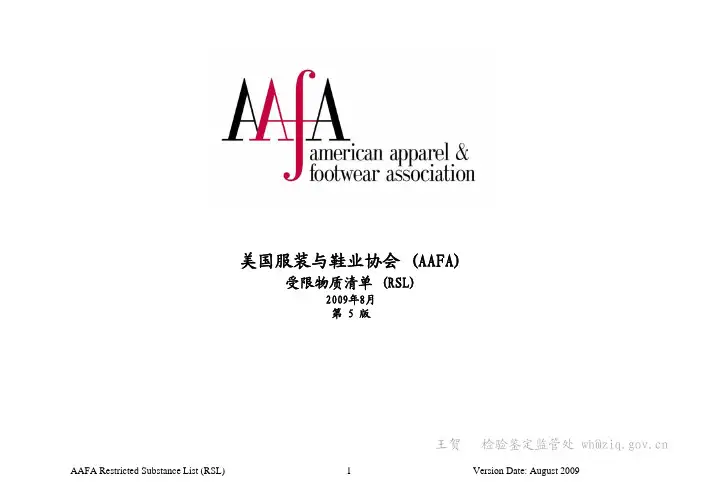
美国服装与鞋业协会 (AAFA)受限物质清单 (RSL)2009年8月第 5 版王贺 检验鉴定监管处 wh@介绍受限物质清单(RSL) 由美国服装与鞋业协会 (AAFA)环境工作组之特别工作组创建. RSL是为了提供相关法律和法规之信息给服装和鞋业公司,这些法律和法规限制或禁止存在于全球家用纺织品,服装,和鞋类成品中某些化学品和物质.我们希望这个 RSL作为实用工具以帮助那些在纺织,服装和鞋业公司里的个人, 和他们的供应商,在整个供应链承担符合环境要求的义务,更多地意识到存在各种各样的国家法规,它们管辖大量允许在家用纺织品,服装,和鞋类成品使用的物质.我们努力创造一个有活力和有用的手段. RSL 会定期更新和增补,以帮助这些公司的行政官员在化学品管理方面进行负责任的做法.王贺 检验鉴定监管处 wh@方法RSL仅包括那些为法律法规限制或禁止的材料,化学品,和物质,它们存在于家用纺织品,服装,和鞋类成品中。
在每一种情形下,RSL识别出大部分限制性规定RSL 不包括那些限制在工厂生产过程中使用物质的规定; 而是关注是否能在家用纺织品,服装,和鞋类成品中发现一定含量的物质.A. 结构对每种物质, RSL 确定以下要素:1. CAS 号码2. 常见化学或颜色名称3. 有关最终产品或测试部件限制/限量信息a. 限制水平b. 发现有限制/限量的国家c. 试验方法d. 有同等或较少限制的国家e. 注释 (如适用)B.包括和不包括RSL 无意于处理化学品管理领域以外的产品安全规定– 例如消费品安全委员会 (CPSC) 涉及小零件的规定。
此外,它没有被安排包含玩具,车用纺织品,或其他织物. 该清单不包括涉及包装或相关材料中物质使用之限制。
因为没有监管浓度限量,以下法规没有列出,但有必要评估其适用性.1. 遵循蒙特利尔议定书,美国环保署,颁布有关消耗臭氧层的化合物之法规. 产品或包装制造过程中使用的I 级和 II 级已列明化学品需要特别标签,详见该法规. 产品或包装中化学成分残留不必满足该要求t. 可少量用来织物污点清洁.2. 加州65号提案要求标记那些已公布致癌化学物品之产品.通常对标签的要求取决于消费者在化学品中暴露水平,而不是产品中的浓度. 在加州凭借法律协议,已经限定了特定用途,产品,或使用中的某些化学品之暴露水平。
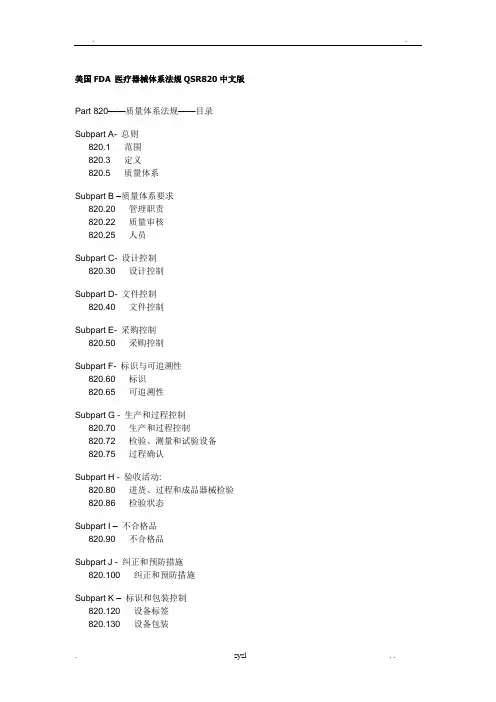
美国FDA 医疗器械体系法规QSR820中文版Part 820——质量体系法规——目录Subpart A- 总则820.1 范围820.3 定义820.5 质量体系Subpart B –质量体系要求820.20 管理职责820.22 质量审核820.25 人员Subpart C- 设计控制820.30 设计控制Subpart D- 文件控制820.40 文件控制Subpart E- 采购控制820.50 采购控制Subpart F- 标识与可追溯性820.60 标识820.65 可追溯性Subpart G - 生产和过程控制820.70 生产和过程控制820.72 检验、测量和试验设备820.75 过程确认Subpart H - 验收活动:820.80 进货、过程和成品器械检验820.86 检验状态Subpart I –不合格品820.90 不合格品Subpart J - 纠正和预防措施820.100 纠正和预防措施Subpart K –标识和包装控制820.120 设备标签820.130 设备包装Subpart L –搬运/储存/分销和安装820.140 搬运820.150 贮存820.160 分销820.170 安装Subpart L –记录820.180 记录的通用要求820.181 设备主要记录820.184 设备历史记录820.186 质量体系记录820.198 投诉文件Subpart M –服务820.200 服务Subpart N –统计技术820.250 统计技术Subpart A——总则Subpart A--General ProvisionsSec.820.1 范围Sec. 820.1 Scope.(a)适用性Applicability。
(1)本质量体系法规阐明了当前良好制造法规Current good manufacturing practice (CGMP)的要求。
本标准适用于所有预期用于人类的成品器械的设计、制造、包装、标识、储存、安装和服务中所使用的管理方法、设施和控制。
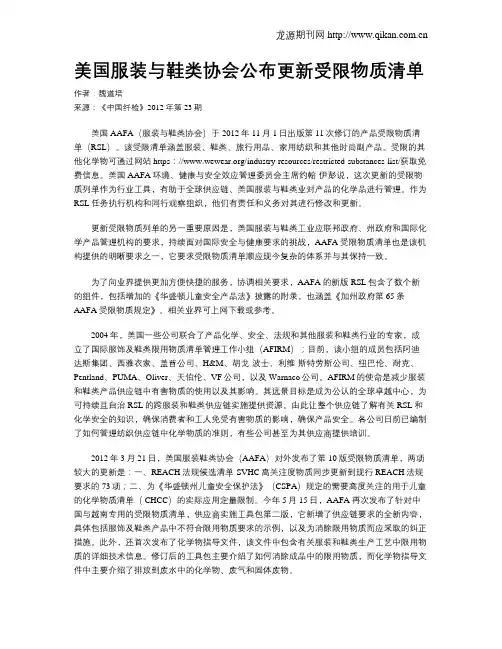
美国服装与鞋类协会公布更新受限物质清单作者:魏道培来源:《中国纤检》2012年第23期美国AAFA(服装与鞋类协会)于2012年11月1日出版第11次修订的产品受限物质清单(RSL)。
该受限清单涵盖服装、鞋类、旅行用品、家用纺织和其他时尚副产品。
受限的其他化学物可通过网站https:///industry-resources/restricted-substances-list/获取免费信息。
美国AAFA环境、健康与安全效应管理委员会主席约翰·伊彭说,这次更新的受限物质列单作为行业工具,有助于全球供应链、美国服装与鞋类业对产品的化学品进行管理。
作为RSL任务执行机构和同行观察组织,他们有责任和义务对其进行修改和更新。
更新受限物质列单的另一重要原因是,美国服装与鞋类工业应联邦政府、州政府和国际化学产品管理机构的要求,持续面对国际安全与健康要求的挑战,AAFA受限物质清单也是该机构提供的明晰要求之一,它要求受限物质清单顺应现今复杂的体系并与其保持一致。
为了向业界提供更加方便快捷的服务,协调相关要求,AAFA的新版RSL包含了数个新的组件,包括增加的《华盛顿儿童安全产品法》披露的附录,也涵盖《加州政府第65条AAFA受限物质规定》。
相关业界可上网下载或参考。
2004年,美国一些公司联合了产品化学、安全、法规和其他服装和鞋类行业的专家,成立了国际服饰及鞋类限用物质清单管理工作小组(AFIRM);目前,该小组的成员包括阿迪达斯集团、西雅衣家、盖普公司、H&M、胡戈·波士、利维·斯特劳斯公司、纽巴伦、耐克、Pentland、PUMA、Oliver、天伯伦、VF公司,以及Warnaco公司。
AFIRM的使命是减少服装和鞋类产品供应链中有害物质的使用以及其影响。
其远景目标是成为公认的全球卓越中心,为可持续且自治RSL的跨服装和鞋类供应链实施提供资源。
由此让整个供应链了解有关RSL和化学安全的知识,确保消费者和工人免受有害物质的影响,确保产品安全。
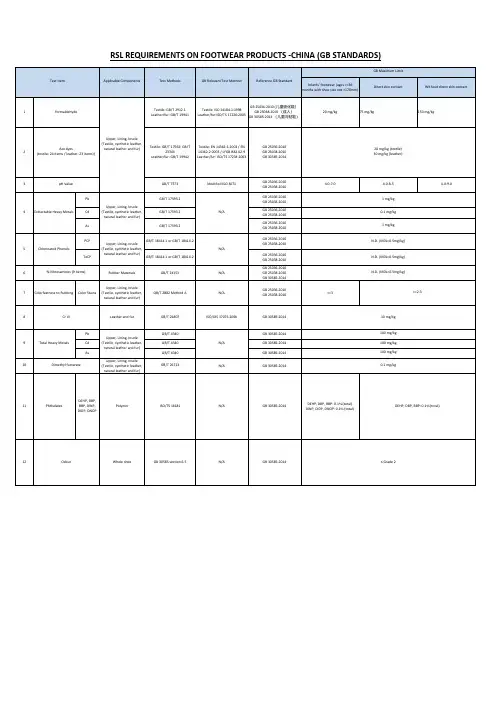
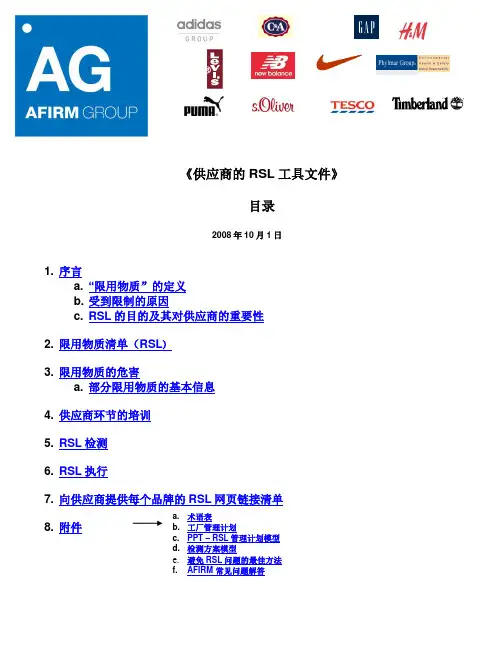
《供应商的RSL 工具文件》目录2008年10月1日1. 序言a. “限用物质”的定义b. 受到限制的原因c. RSL 的目的及其对供应商的重要性2. 限用物质清单(RSL )3. 限用物质的危害a. 部分限用物质的基本信息4. 供应商环节的培训5. RSL 检测6. RSL 执行7. 向供应商提供每个品牌的RSL 网页链接清单8. 附件a. 术语表b. 工厂管理计划c. PPT – RSL 管理计划模型d.检测方案模型e. 避免RSL 问题的最佳方法f. AFIRM 常见问题解答注:本文件旨在为服饰及鞋类供应商提供协助其执行限用物质清单(RSL)要求所需的全面意见和基本信息。
读者不应依赖本文件去解决特定问题。
本文件不对本文信息的完整或用途做任何明确或暗示的保证。
此外,国际服饰及鞋类限用物质清单管理工作小组(AFIRM)不对任何因使用或依据本文件内容而导致的任何情况负责。
《服饰及鞋类供应商的RSL工具文件》2008年10月1日1. 序言国际服饰及鞋类限用物质清单管理工作小组(AFIRM)以制定本《RSL工具文件》为其使命的一部分,目的是要“减少服饰及鞋类供应链中有害物质的使用和影响。
”本文件为RSL计划的执行提供了全面意见。
RSL 计划的执行是一个高度个体化的过程,受到许多因素的影响,包括生产的产品及其销售地。
其实许多品牌也有自己的RSL执行方针,并鼓励供应商在可用的情况下采用。
AFIRM对美国服饰及鞋类协会(AAFA)在限用物质清单及其执行指南上作出的贡献表示感谢,正是这些信息构成了本文件的基础。
“限用物质”的定义限用物质是指在某一特定制造过程中,其使用受到法律或各品牌的禁止或限制的化学品和其他物质。
通常情况下,限用物质不能存在成品中,或其浓度须在限制范围内。
限用物质可能在一个或多个行业,或者在某些特定的产品或材料中被禁止或限制使用。
其他可能相关的术语见附件A。
受到限制的原因这些物质受到限制的原因有许多。

美国FDA 医疗器械体系法规QSR820中文版Part 820——质量体系法规-—目录Subpart A—总则820。
1 范围820.3 定义820。
5 质量体系Subpart B –质量体系要求820.20 管理职责820.22 质量审核820.25 人员Subpart C—设计控制820。
30 设计控制Subpart D—文件控制820.40 文件控制Subpart E—采购控制820.50 采购控制Subpart F- 标识与可追溯性820。
60 标识820。
65 可追溯性Subpart G —生产和过程控制820。
70 生产和过程控制820。
72 检验、测量和试验设备820.75 过程确认Subpart H —验收活动:820。
80 进货、过程和成品器械检验820.86 检验状态Subpart I –不合格品820.90 不合格品Subpart J - 纠正和预防措施820。
100 纠正和预防措施Subpart K –标识和包装控制820。
120 设备标签820。
130 设备包装Subpart L –搬运/储存/分销和安装820.140 搬运820。
150 贮存820。
160 分销820.170 安装Subpart L –记录820.180 记录的通用要求820。
181 设备主要记录820。
184 设备历史记录820.186 质量体系记录820。
198 投诉文件Subpart M –服务820。
200 服务Subpart N –统计技术820.250 统计技术Subpart A-—总则Subpart A--General ProvisionsSec。
820。
1 范围Sec. 820.1 Scope.(a)适用性Applicability。
(1) 本质量体系法规阐明了当前良好制造法规Current good manufacturing practice(CGMP)的要求。
本标准适用于所有预期用于人类的成品器械的设计、制造、包装、标识、储存、安装和服务中所使用的管理方法、设施和控制。
American Apparel & Footwear Association (AAFA) Restricted Substance List (RSL)May 2014 | Release 14Table of ContentsIntroduction 3Methodology 4About AAFA 6Arylamines 7Asbestos 8Dioxins & Furans 9Disperse Dyes 10Flame Retardants 11Fluorinated Greenhouse Gases 13Metals 14Miscellaneous Chemicals 17Organotin Compounds 20Pesticides 21Phthalates 23Solvents 25Glossary 26Appendix I - Reporting*29Appendix II - Labeling†40Appendix III - Labeling‡41Changes from RSL 13 to RSL 14 43Disclaimer 45* Appendix I lists regulations which have a reporting requirement that are not necessarily otherwise listed in the RSL. † Appendix II lists regulations which have a labeling requirement that are not necessarily otherwise listed in the RSL. ‡IntroductionThis Restricted Substance List (RSL) was created by a special working group of the American Apparel & Footwear Association’s (AAFA) Environmental Task Force. The RSL is intended to provide apparel and footwear companies with information related to regulations and laws that restrict or ban certain chemicals and substances in finished home textile, apparel, and footwear products around the world. It is our hope that this RSL will serve as a practical tool to help those individuals in textile, apparel and footwear companies, and their suppliers, responsible for environmental compliance throughout the supply chain, to become more aware of various national regulations governing the amount of substances that are permitted in finished home textile, apparel and footwear products.Our effort is to create a dynamic and useful instrument. The RSL will be updated on a regular basis and will be supplemented with additional resources to help officials in these companies undertake responsible chemical management practices in the aforementioned finished products.MethodologyThe RSL includes only those materials, chemicals, and substances that are restricted or banned in finished home textile, apparel, and footwear products because of a regulation or law. In each case, the RSL identifies the most restrictive regulation.The RSL does not include regulations that restrict the use of substances in production processes or in the factory; rather the focus is on whether or not the substance can be found in finished home textile, apparel, and footwear products at a certain level.A. StructureFor each substance the RSL identifies the following features:1. CAS number2. Common chemical or color name3. Information on the Restriction/Limit on Final Product or Tested Componenta. Restriction Levelb. Country where that Restriction/Limit is foundc. Test Method (where no test method is stipulated in the regulation, the GAFTIcolumn may suggest one)d. Other countries that maintain equal or less restrictionse. Comments (if applicable)B. What is Included and What is NotThe RSL is not intended to address product safety regulations outside the chemical management area – such as Consumer Product Safety Commission (CPSC) regulations related to small parts.Moreover, it is not structured to cover toys, automotive textiles, or other industrial textiles. This list does not include restrictions related to use of substances in packaging or related materials.The following legislation is not listed because there are not regulatory concentration limits but may warrant evaluation for applicability.1. The US EPA, following the Montreal Protocols, promulgated legislation on ozone depletingcompounds. Class I and Class II listed chemicals used in the process of manufacturing ofproduct or packaging requires special labeling as detailed in the regulation. Residuals ofthe chemical components in the product or package are not necessary to trigger therequirement. Minor usage in textiles as a spot cleaner is acceptable.2. California Proposition 65 requires a “clear and reasonable” warning label for all productssold in the state of California containing one or more chemicals known to the state to causecancer or reproductive toxicity. Labeling requirements are dependent on consumerexposure to the chemical (measured in micrograms (μg)/day) not the concentration in theproduct. To comply with the law, manufacturers must either ensure that consumer exposureto regulated chemicals in their products do not exceed the established safe harbor levels orlabel their products. For more information on California Proposition 65, please visit ourwebsite at https:///aafa-on-the-issues/category/?CategoryId=82.3. For more information on other non-regulated chemicals AAFA has developed a separatetool based on the work done by the AFIRM group. This tool can be found on our website(https:///assets/1/7/103112NonRegulatedRSL.pdf) and includes chemicalsthat are neither regulated nor proven to be dangerous, but may be of note to the industry.C. Technical Notes1. Chemical nomenclature can take several forms. Technical chemical names may takenumerous forms. It is the responsibility of the user to verify synonyms of any regulatedchemicals referenced.2. It is possible that regulated components may be present in raw materials below the levelsthat require reporting on Material Safety Data Sheets (MSDS). Care should be taken toverify the presence of all regulated ingredients regardless of the concentration.3. This list represents the known and applicable standards at the time of publication; anyinaccuracy or omission is not the responsibility of AAFA.4. Test methods noted in blue are the GAFTI recommended test methods.D. GAFTI Comments1. The members of the Global Apparel, Footwear and Textile Initiative (GAFTI) havecollaboratively produced recommended test methods for certain chemicals in cases wherethe test method is not stipulated by the regulation. This is an ongoing process, and testmethods will continue to be added in subsequent releases of the RSL.About GAFTIGlobal Apparel, Footwear and Textile Initiative is an initiative to bring retailers, brands, mills and factories together to improve efficiencies and set standards globally.Because there is no single source of standards, there is a lack of standardization in the apparel, textile, and footwear industry. This gap creates conflicting requirements across customers.GAFTI’s goal is to reduce complexity and remove costs from common industry practices and prevent increased scrutiny from press and governments, which could lead to increased regulation.For more information see: ABOUT AAFAThe American Apparel & Footwear Association (AAFA) is the national trade association representing apparel, footwear and other sewn products companies, and their suppliers, which compete in the global market. AAFA's mission is to promote and enhance its members' competitiveness, productivity and profitability in the global market by minimizing regulatory, commercial, political, and trade restraints.AcknowledgementsThe AAFA gratefully acknowledges the support and contribution of the past and present members of the RSL Task Force in developing the RSL. The current members of the RSL Task Force are listed below.RSL Task Force:John Eapen, American & Efird, Inc.Andre Leroy, Avery Dennison Retail Branding Information SystemsRick Horwitch, Bureau Veritas Consumer ProductsElizabeth Hausler, Bureau VeritasMeg Hughes, Bureau Veritas Consumer ProductsMatt Nudell, Bureau Veritas Consumer ProductsTim Mattulke, Bureau Veritas Consumer ProductsBrian Eichelberger, PhD, Consumer Testing Laboratories, Inc.Nate Sponsler, GAP Inc.Tommy Thompson, Hanesbrands, Inc.Sam Moore, PhD, Hohenstein Institute America, Inc./Oeko-TexVicky Au, Intertek Testing Services Hong Kong LtdPratik Ichhaporia,Ph.D, Intertek Consumer Goods North AmericaSeemanta Mitra, Intertek Consumer Goods North AmericaAndy Kahn, Kahn Lucas LancasterJohn R Gerringer, Modern Testing Services, LLCJongsei Park, PhD, Modern Testing Services, LLCAndy Chen, PhD, Nike Inc.Manfred Wentz, North Carolina State UniversityJean-Pierre Haug, PhD, The International Oeko-Tex AssociationSanjeev Gandhi, PhD, SGS Consumer Testing ServicesHelmut Krause, PhD, SGS Consumer Testing ServicesMeena Kumari, TÜV SÜDAnne Bonhoff, PhD, UL-STRLisa Clerici, Under ArmourSean Cady, VF CorporationHarsha Chenna, VF CorporationKitty Man, PhD, VF CorporationArthur Herold, Webster, Chamberlain & BeanJames Wilson, Webster, Chamberlain & BeanAAFA also acknowledges the contributions of the following individuals who served as Peer Reviewers of this RSL.Peer Review Group:Elizabeth Treanor, AFIRMMichael Walls, American Chemistry CouncilHenry Boyter, Ph.D, Center for Environmentally Sustainable Textile and Apparel BusinessesJohn Easton, PhD, Dystar, Inc.Antonio Barberi Ettaro, MODINTNick Odom, Springs IndustriesKilian Hochrein, W.L.Gore & Associates, Inc.。
美国服装鞋业协会公布第四版全球禁用物质清单
佚名
【期刊名称】《纺织商业周刊》
【年(卷),期】2009(000)010
【摘要】近日,美国服装鞋类协会(AAFA)公布了其全球限制物质名单RSL (Restricted Substances List)第四版修正稿,这份名单包括了各国政府以法律或法规的形式来进行限制的化学品和在产品中包含的其他物质,其中既包括了目前已经被世界上大多数国家和地区认为有害的物质.例如甲醛、杀虫剂、重金属、阻燃剂、石棉,也包括了最新被欧盟禁用的DMF(富马酸二甲酯)等物质,涉及到的最终产品主要有家用纺织品、服装和鞋履等。
【总页数】1页(P5)
【正文语种】中文
【中图分类】TS941.2
【相关文献】
1.英国鞋类研究协会威德克博士在美国发表演说展望2010年全球鞋业 [J],
2.美国服装与鞋类协会公布更新受限物质清单 [J], 魏道培
3.美国纺织服装鞋业协会 [J],
4.美国服装鞋业协会赞成奥巴马签署化学品安全法案 [J], 冉福林
5.美国纺织服装和鞋协会发布第17版限用物质清单 [J],
因版权原因,仅展示原文概要,查看原文内容请购买。
美国AAFA的RSL解读(上)
王建平;吴岚;朱雯喆
【期刊名称】《纺织导报》
【年(卷),期】2009(000)006
【摘要】继2007年6月推出首版《限用物质清单》(Restricted Substances List,简称RSL,下同)之后,仅仅过了7个月时间,AAFA于2008年2月推出了RSL第二版。
除了少量版式上的调整,新版RSL在技术内容上并无实质性的变化。
2008年7月,AAFA推出了其RSL第三版。
这次改版,主要是在引用法规、技术内容勘误和限用物质增删等方面作了少量的调整。
【总页数】5页(P95-99)
【作者】王建平;吴岚;朱雯喆
【作者单位】上海天祥质量技术服务有限公司;上海天祥质量技术服务有限公司;上海天祥质量技术服务有限公司
【正文语种】中文
【相关文献】
1.美国AAFA的RSL解读(下) [J], 王建平;吴岚;朱雯喆
2.美国汽车后市场零部件分销状况解读(上) [J], Karen Fierst;张淑珍
3.美国发布新版RSL清单 [J],
4.舌尖上的“印度”--解读印裔美国作家拉希莉《同名人》中的食物政治 [J], 黄新辉
5.美国成衣暨鞋类协会(AAFA)发布裤袜、丝袜和袜子的测试标准 [J],
因版权原因,仅展示原文概要,查看原文内容请购买。